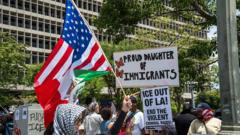In Maryland, Victor Moran, the chief executive at a cleaning company employing 1,200 people, is becoming increasingly concerned about his ability to staff his business as President Donald Trump’s immigration policies tighten. Despite thorough vetting processes for new hires, he reports losing approximately 15 workers since the administration revoked temporary protections for immigrants from Nicaragua and Venezuela, threatening a potential loss of hundreds more if the crackdown widens.
Similar apprehensions echo through various sectors in the U.S., where Trump's immigration enforcement strategies could result in significant worker shortages at a time when immigrant labor is crucial for the economy. Census data shows that immigrants represented nearly 20% of the workforce last year, a significant increase from less than 10% in 1994.
The administration's current focus primarily targets undocumented individuals, constituting about 4% of the workforce, a key component of Trump's campaign promises that initially garnered support from numerous voters, including those in Hispanic communities. Workplace raids, which had been suspended under President Biden, have resumed, while the administration pushes to revoke work permits and other protections historically granted by predecessors.
Justino Gomez, a 73-year-old immigrant from El Salvador residing in Maryland, expressed fear for his future under these changes, which have led to heightened anxiety about his safety and stability. Benefiting from the Temporary Protected Status (TPS), Gomez has contributed to his family back home through his hard work in various jobs for three decades. He now fears that the TPS program, which safeguard hundreds of thousands like him, could be dismantled next.
Economic experts warn that beyond the immediate fears faced by workers, Trump’s actions could adversely affect the economy. Giovanni Peri, an economist from the University of California, Davis, notes that a shrinking workforce will limit business growth and may trigger inflation as companies struggle to fill roles. Historical comparisons highlight how similar restrictive immigration policies in countries like Japan led to economic stagnation, suggesting a troubling trajectory for the U.S.
Companies in sectors like elder care are already experiencing the fallout, as foreign-born individuals comprise a significant portion of the workforce. Adam Lampert, who runs Cambridge Caregivers, observed that around 80% of his staff hail from abroad, and he noted the challenges in filling positions as worker shortages loom. High demand for care workers due to an aging population could exacerbate these issues, and Lampert warned of inevitable inflation should these immigrants be forced from the labor pool.
Major healthcare providers are similarly struggling. Harris Health System’s chief executive, Esmail Porsa, stated that it would take considerable time to train American workers to meet the increasing demands of the aging populace if immigrant labor continues to be marginalized.
Acknowledging the challenges posed by his policies, Trump has indicated he would temporarily ease some enforcement in certain industries. However, Department of Homeland Security officials maintain that workplace raids are pivotal to their strategy going forward.
The construction industry is also feeling the strain, with reports of work crews disappearing from job sites. Jim Tobin, president of the National Association of Homebuilders, noted rising costs and slowdowns in projects, calling for immigration reforms to ensure a stable labor force, although immediate changes appear unlikely.
The ongoing enforcement has brought to light a critical dilemma in U.S. immigration policy: balancing deportation efforts against the workforce needs essential for economic health.





















